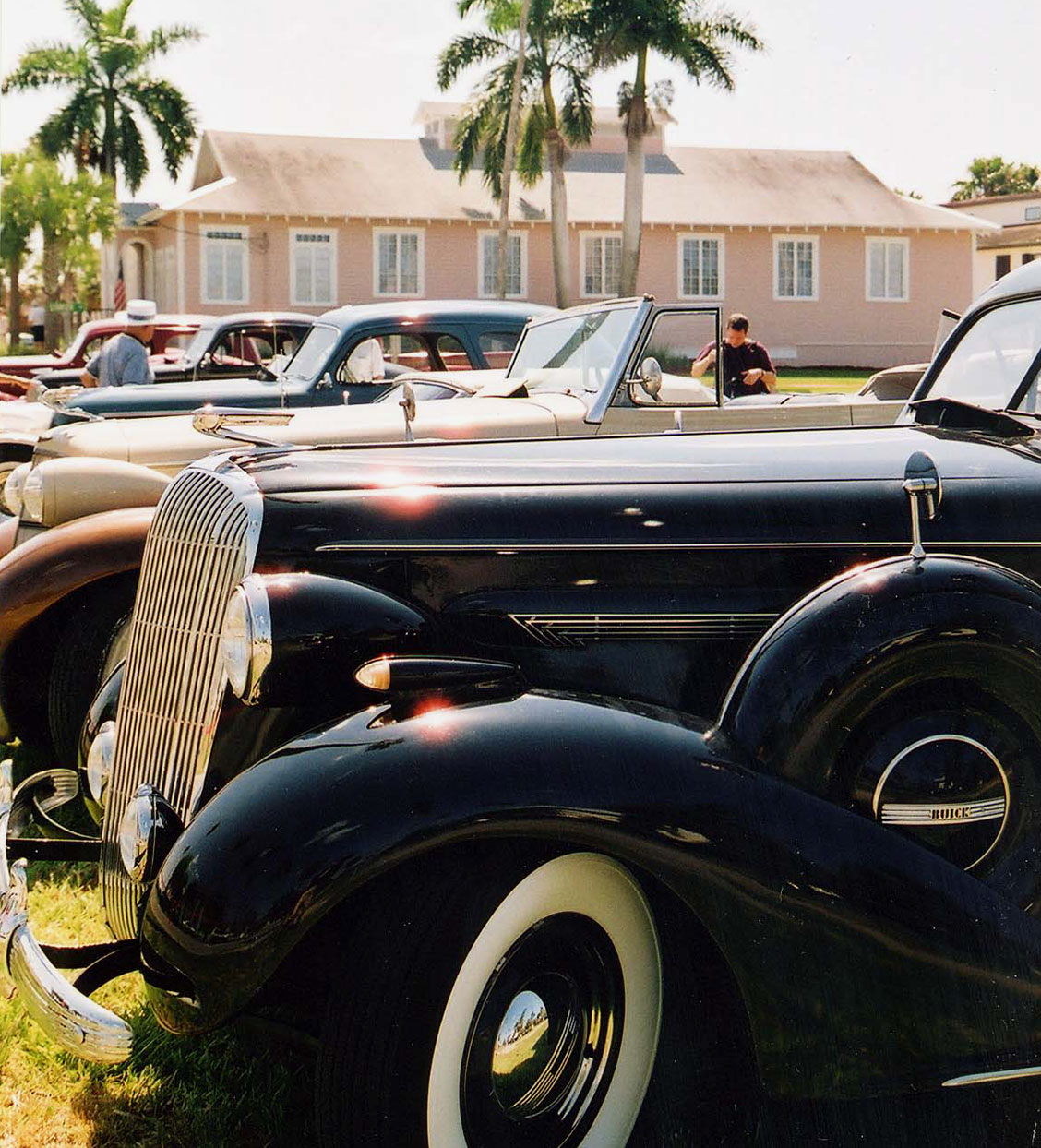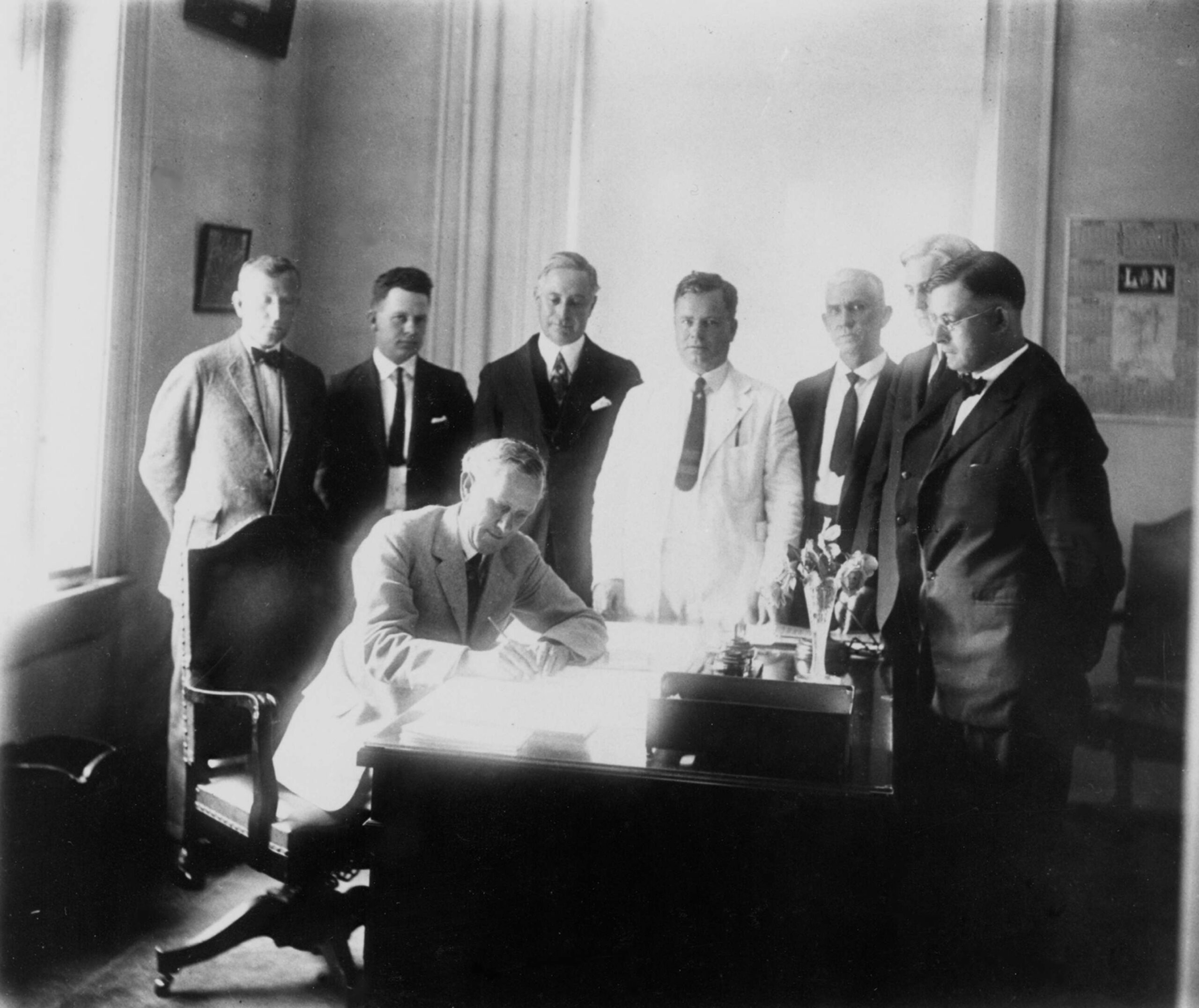
Collier County has been a home for southwest Floridians for over 10,000 years. Our earliest residents were the Paleoindians, hunter – gatherers who lived among an abundance of Ice Age megafauna such as Columbian mammoths and saber – tooth ed cats . These residents enjoyed a dry, temperate grassland and could be considered our area’s first snowbirds. Our county was also once part of the Calusa domain, which extended from the Ten Thousand Islands all the to the far reaches of Charlotte Harbor. The Calusa, or “fierce people , ” defended our coast from any attempts at Spanish colonization until their eventual demise in the 1700s. The Seminoles of north Florida made their way to what would become Collier County in the early 1800s, hunting in the high prairies of o ur northern interior and living in the cypress swamps in the south. While a variety of black, white, and Hispanic settlers found their way into the region throughout the 1850s and 1860s, it was not until the 1870s that permanent settlement began in the tow ns and communities that would become Everglades City, Marco Island, Immokalee, and Naples.
Politically, Collier County has held many names. When the State of Florida was established in 1845 we were part of Monroe County, with our county seat residing in Key West. In 1887 we were part of the newly formed Lee County, and while a trip to the county seat in Fort Myers was certainly less burdensome than Key West, it still made getting business done difficult for the residents of the southern portion of the count y. This relative isolation of these southern communities also slowed their growth considerably, even as the rest of Florida was blossoming by the early 20th century. Naples, Marco, Caxambas, and Everglade could only be accessed easily by boat. A road connecting Immokalee to Fort Myers had only finally opened in 1917. Railroads only went as far as Fort Myers until the mid – 1920s. Despite the isolation, there were many people with money , affluence, and influence who saw the potential of this region and who were ready to make investments in its future.
In 1911, an advertising magnate from Tennessee by way of New York named Barron Gift Collier visited Florida for the first time. He stayed at his friend John Roach’s island in the Pine Island Sound off the coast of Lee County, Useppa. Collier quickly became enamored by the beauty and resources — the tourism potential — that the region offered and bought Useppa Island from his friend. Roach also introduced Collier to his property in south Lee County at Deep Lake, a citrus grove with a narrow gauge railroad track that was a little over 10 miles from the town of Everglade. Collier bought that from Roach as well, in 1916. Collier’s investment in the region continued , and between 1921 and 1923 alone he accumulated over one million acres of land in south Lee County. Knowing that his business ventures would be more successful with better transportation options, h e had a keen interest in t he Tamiami Trail project, which had been initiated by the State Road Department in 1914 to connect the west and east coasts of south Florida . The project was to be financed by the counties that this road would go through. Unfortunately for Lee County, a large portion of their project required its investment in pricey engineering and construction, and with a relatively small tax base compared to other counties the project quickly ran out of money and steam. Barron Collier, seeing an opportunity to leave a legacy in an area he loved , offered to fund the construction of the Tamiami Trail through the swamps of the Everglades in exchange for a new county to be formed and named in his honor. On May 8th , 19 2 3 Collier County was officially partitioned from Lee County by the Florida State Legislature. The Town of Everglades (now Everglades City) was the original county seat.
Today Collier County encompasses 2,305 square miles of land. It is the second largest county by size in the state of Florida (behind Palm Beach County) as well as bigger than both the states of Rhode Island and Delaware. In 1962 the county seat was moved to East Naples, making it the only county seat in an unincorporated area at the time.
Photo Information: B&W. Shows Florida Governor Carey A. Hardee (seated on left) signing bill which established Collier County on May 8, 1923. Barro n G. Collier shown third from right, standing behind the Governor. D.W. McLeod on far right.
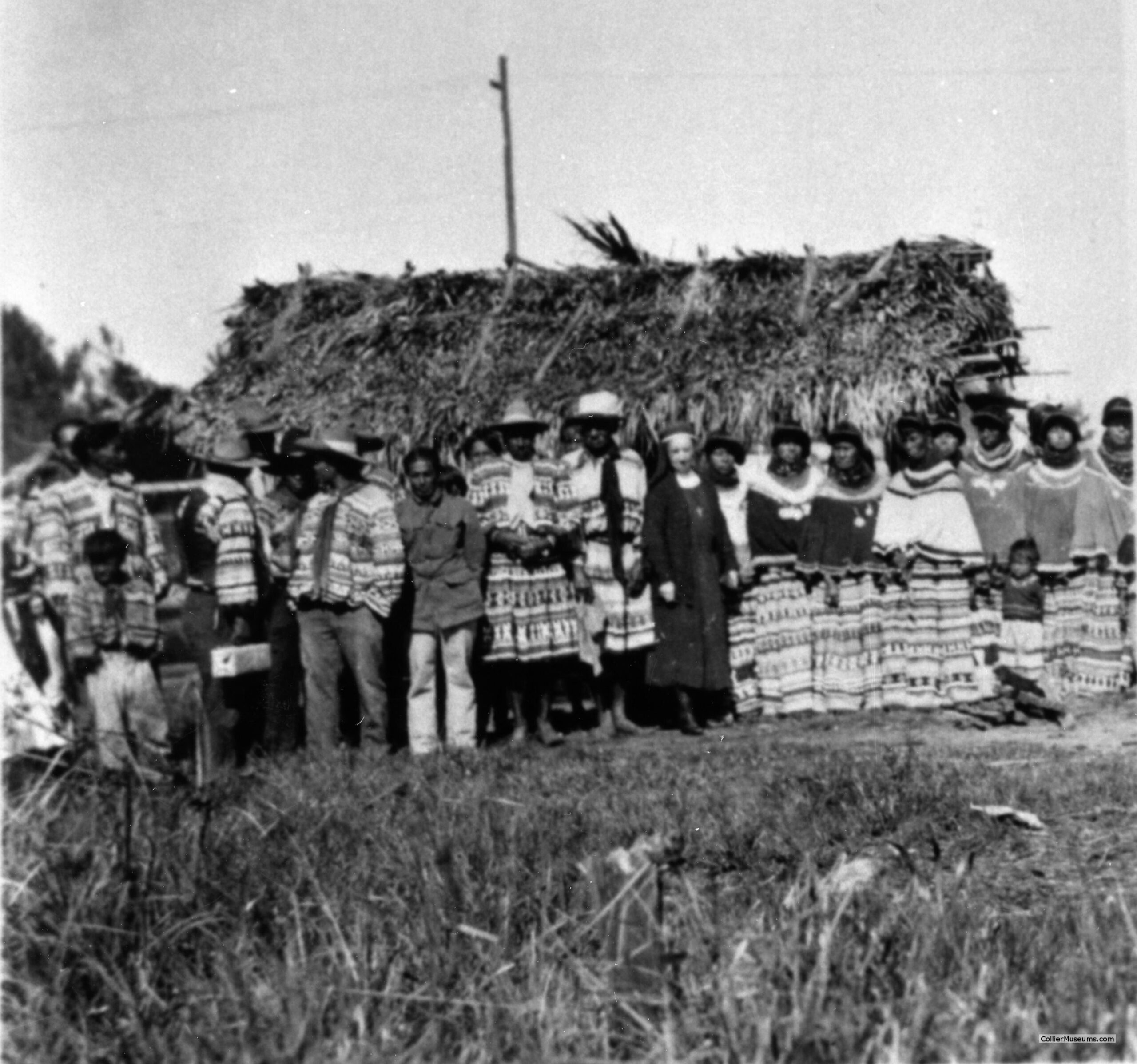
The Seminole people have lived in Florida for thousands of years and were here when the Spanish first arrived. They were called Muscogee, Miccosukee, Calusa and other tribal names. The Spanish also called them cimarrónes – meaning runaways or the wild ones – because they refused to join the Spanish Mission system.
The Seminole War, 1816 – 1856, (known as the Seminole Wars in American textbooks) pushed the Seminoles south into the Everglades. Their superior understanding of the land assisted them in evading Federal troops and the government’s attempt to remove and destroy them.
After the war years, the Seminoles quickly returned to keeping cattle. They were among the earliest to drive cattle to Immokalee.
Eventually pioneers and technology caught up with the Florida Seminoles. In the lands now known as Collier County, the Seminoles adapted and built a new life. They traded hides and feathers at trading posts like Brown’s Landing outside Immokalee, Storters’ in Everglades City, and Smallwood’s in Chokoloskee with the influx of newcomers.
When dredging lowered the water table in the Everglades and the Tamiami Trial cut through many of their canoe paths, the Seminoles set up their own stores and tourist attractions. They had learned which of their crafts would sell well, how to run strong businesses, and how to wrestle alligators in front of tourists.
To learn more about the Seminoles Tribe of Florida, visit here and to learn more about the Miccosukee Tribe of Indians of Florida, visit here.
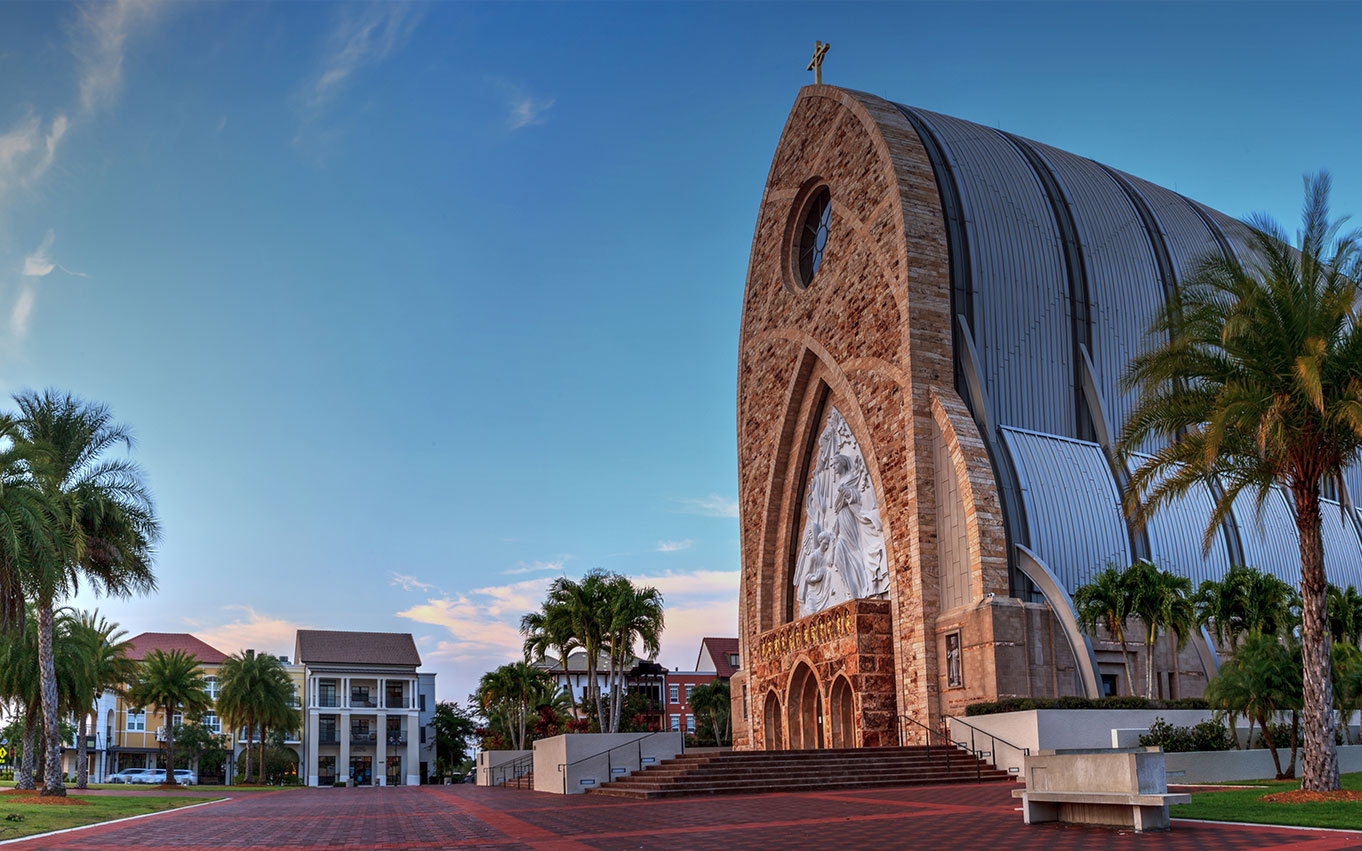
Construction for Ave Maria University and the surrounding town started in 2005. The project to build the new university and town resulted from a partnership between Catholic philanthropist Tom Monaghan and the Barron Collier Company. Monaghan, the founder of the Domino’s Pizza chain, wanted to start a new Catholic university and launched a college in Michigan which soon outgrew its campus. Looking for a new home for the school, he focused on Southwest Florida. The Baron Collier Company offered 1,000 acres of land in Collier County with the idea of developing a town around the university.
Ave Maria University opened a temporary campus in Naples in 2003, and construction started on the new campus and the town in 2005. The first business in the town opened in 2007, and classes at the new university campus started in the 2007-08 academic year.
Ave Maria Catholic Church is the town’s most prominent landmark. Originally dedicated as the Ave Maria Oratory, the church opened its doors in 2008 as part of Ave Maria University. The Diocese of Venice purchased the building in 2017.
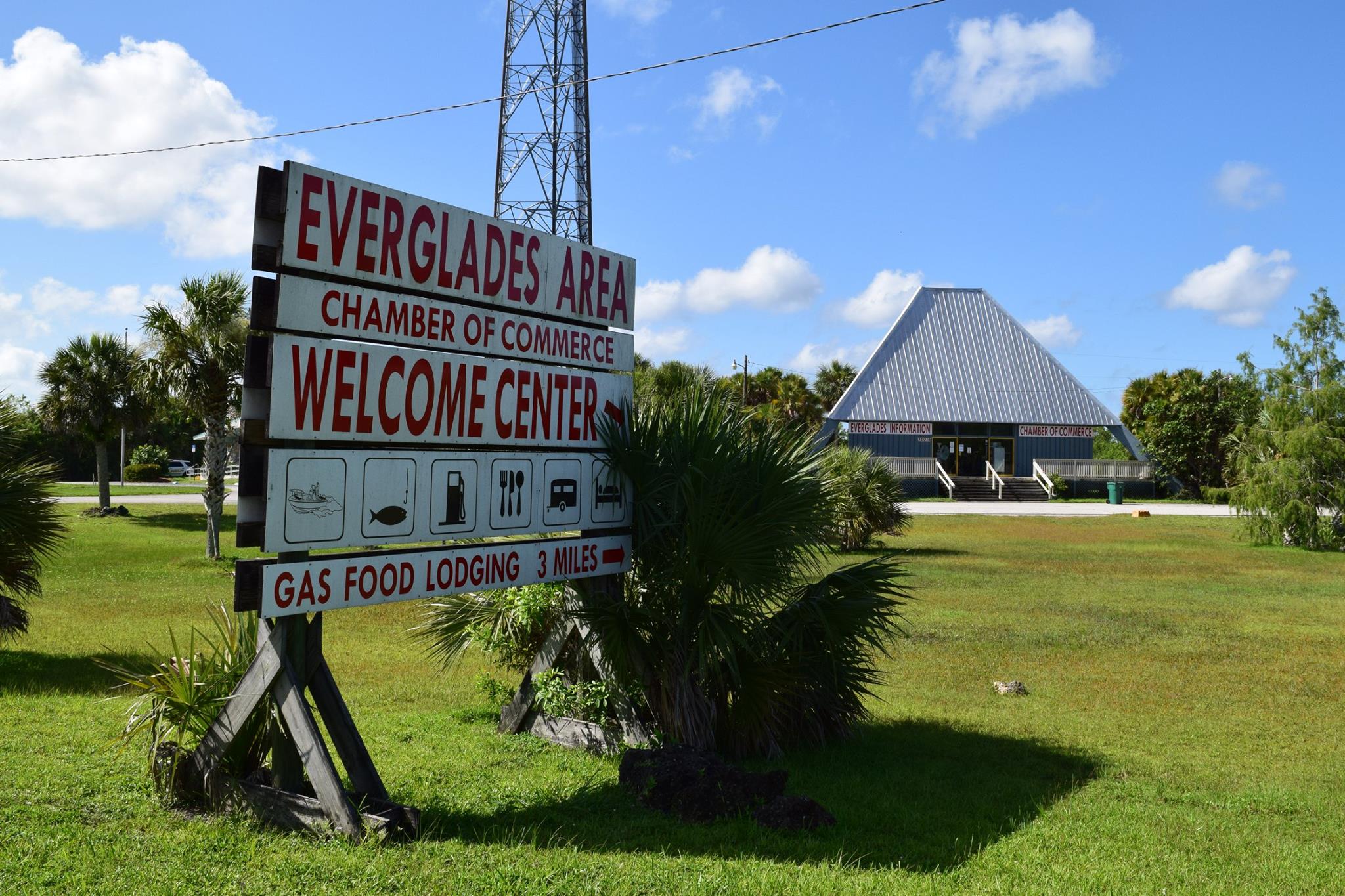
The tracks of Barron Collier’s Deep Lake Railroad, a 16 – mile narrow gauge line built to move grapefruit from a nearby orchard to the port at Everglades, once followed the path of present – day S.R. 29. The bustling hub at the intersection of that route and H ighway 41 (then a dirt track impassable during the rainy season) was known as Carnestown. During the construction of the Tamiami Trail it served as a supply depot and staging area that included sleeping cottages, a dining hall, and a warehouse. After the D eep Lake Railroad was purchased by Atlantic Coast Line rail company and connected to their Haines City line in 1926, Carnestown became a way station for shipments of tomatoes and other goods destined for northern markets. The area was named by Collier in h onor of his son Carnes (also known as “Sam”), and a similar depot to the north, where S.R. 29 now crosses Alligator Alley, was dubbed Miles City after another of his three sons.
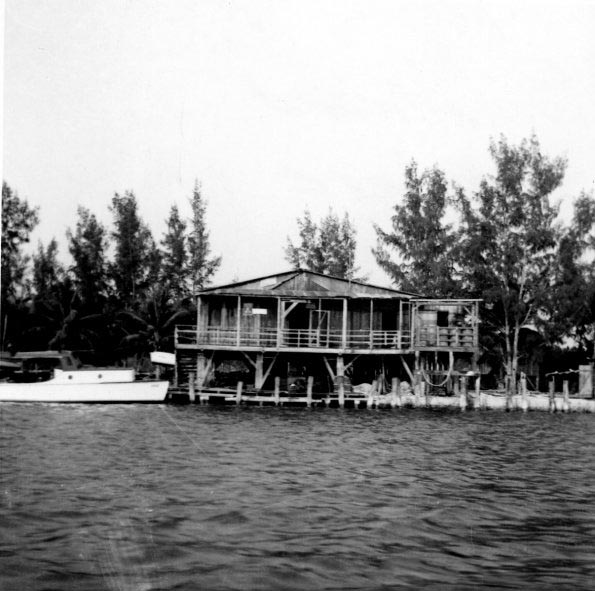
The island of Chokoloskee is almost entirely comprised of shell mounds built by the Calusa Indians. Pioneer settlers began arriving in Chokoloskee shortly after the Civil War, farming the rich soil and planting groves of fruit trees. Resident humorist C.G. McKinney (known as the “Sage of Chokoloskee”) lead the campaign to establish a post office in 1891, originally under the tongue – in – cheek name of “Comfort”, but ultimately renaming it Chokoloskee, Seminole for “old house”, later that year. The most famous resident was Ted Smallwood, who arrived in Chokoloskee (or as the locals call it, “Chuk”), in 1897. In 1906 he established a trading post on the bay known as the Smallwood Store. His store would become a center of frontier commerce, as well as the community’s post office, with both Seminole and Cracker pioneers arriving by boat to purchase supplies or trade pelts and hides for provisions. Chokoloskee and the Smallwood Store feature prominently in local folklore as the site of the “frontier just ice” killing of notorious outlaw Edgar Watson. Accessible only by water until 1955, a bridge was finally built connecting the island to Everglades City that year – ending the practice of conveying local students to class by “school boat”.
Photo caption: Sm allwood’s Store and Post Office on Chokoloskee, seen from the bay. A large mail passenger boat is moored at the left side of the dock.
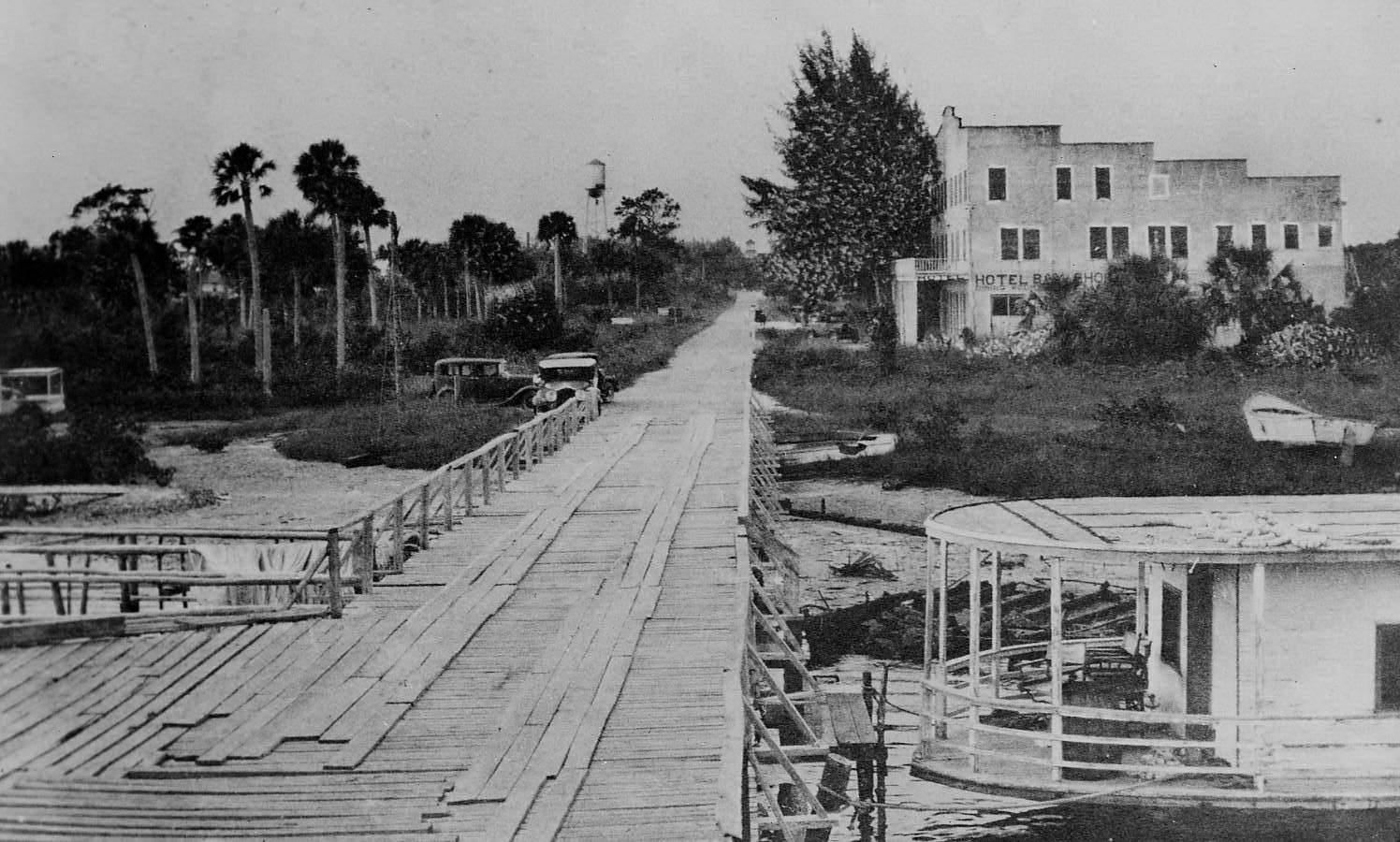
There is much debate about who first coined the name for our little slice of paradise on the Florida Southwest coast. Here, where early promoters likened our balmy climate and expansive bay to that of Naples, Italy, is where we start our story.
Roger Gordon and Joe Wiggins are credited as the first white pionee rs to settle in Naples around 1874 . Both men drifted on a short time later however their legacy in Naples’ history continues today through passes bearing their respective names. Two years later in 1876, Naples gained its first permanent residents when brot hers John and Madison Weeks put down roots near the northern edge of present – day Gordon’s Pass. However, the Weeks brothers were removed from their homestead when Hamilton Disston purchased four – million – acre s of Florida real estate in 1881 – the largest amo unt of land ever bought by a private individual in U. S. history – rescu ing the state from bankruptcy.
Naples’ future changed dramatically in 1887 when two Kentucky gentlemen, John S. Williams and Walter N. Haldeman purchased a combined 112 lots in Naples. Work soon began on building a small, twenty – room hotel at Naples, with six beach cottages . Since road and railroad connections to Naples were still non – existent in the 1880s, the town’s developers began building the first 600 – foot pier to serve as a lifeline to the outside world . A small shed at the shore end served as the town’s first post office.
Without fast and affordable rail service, the town’s financial future could not be sustained. On January 30, 1890, virtually the entire town of Naples, inc luding the hotel, pier, ships, and about 8,600 acres of undeveloped land, was auctioned off to Walter Haldeman, the only bidder, for $50,000.
The Town of Naples was incorporated by a special act of the Florida Legislature in 1923 however the process was n ot completed until several years later when the first town meeting of the Town o f Naples was held. At this meeting, the need for an official mayor became upmost importance for Naples’ town council. On April 13 th , 1925, Kentucky born Speed Menefee was chose n as Naples’ first Mayor. Ever the colorful and eccentric man he was, Menefee chose to resign 15 minutes later, even after being sworn in, reciting the oath, attending the appropriate ceremonies, and giving an acceptance speech. In his place, Judge E. G. W ilkerson was chosen by Naples’ town council to take over the position of Mayor where he served for several years.
While Naples was in flux, Solomon Davies Warfield , Seaboard Air Line Railway chairman and president , l aunch e d an aggressive expansion program to push his railroad across Florida and down the state’s east and west coasts . Warfield’s greatest, and last, project in Southwest Florida was the Seaboard’s new extension from Fort Myers to Naples, a tiny community with less than 300 souls that Warfield enthusiastically promoted as “a most attractive place with beautiful beaches… and one of the best situated winter resorts on the west coast.” The line reached the outskirts of Naples in early December 1926 and was officially opened on January 7, 1927, with a gala celebration and the arrival of the Orange Blossom Special, the pride of the Seaboard fleet.
Along with the railroad connecting Naples to a vast array of railroad routes throughout the country , a major development came about in the way of the “Tamia mi Trail ;”a name coined by the combination of the two cities to be connected by the road, Tampa and Miami. The Tamiami Trail officially opened April 26, 1928, 13 years after it started. At the time the Tamiami Trail was considered a major acheivement of en gineering as it was the only route from Naples, and by extensions, from Tampa, to the southeastern coast of Florida.
The charter of the City of Naples was incorporated June 13, 1949. Structure – population shift. Include the army air field, growth of Naples, population totals.
The number of permanent residents did not reflect the growth of the town. By the time the Seaboard Airline Railroad first rode into Naples, there were only 300 residents. By 1945 there were less than a thousand.
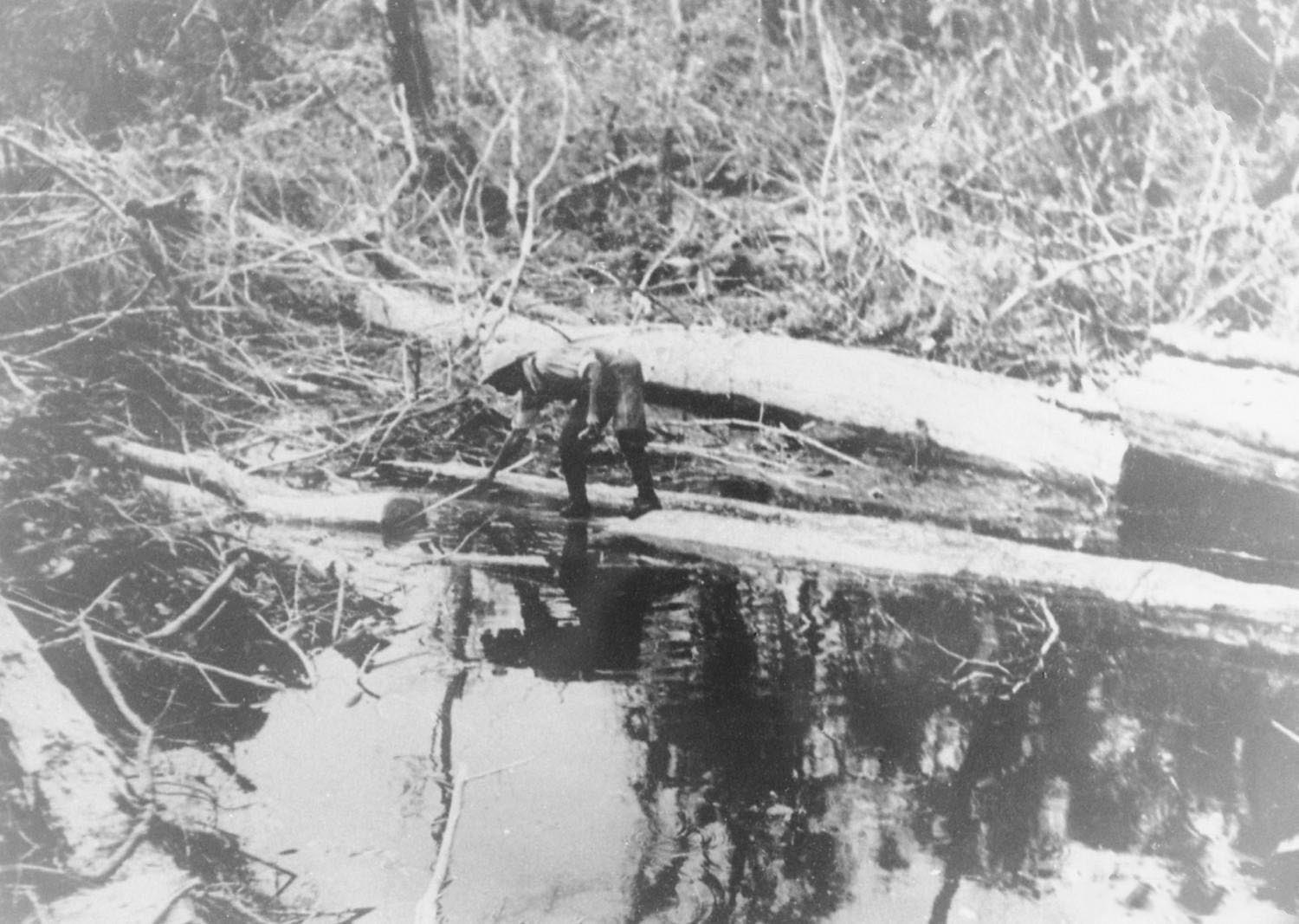
Located just north of U.S. 41 along S.R. 29, Copeland was originally a farming community established by the Janes brothers and Alfred D. Webb. There were homes for workers, a Baptist church and a general store with a restaurant were workers could pay with company tokens marked with a “J”. Named for D. Graham Copeland, Barron Collier’s right hand man who had surveyed the region and established a route for the Tamiami Trail, the town became a center of local logging industry in the 194 0s. The Lee Tidewater Cypress Company camp employed 1000 workers but, as the industries closed down, the town’s population dwindled to just a few dozen homes.
Photo caption: Unidentified workman holding measuring cypress logs at the Lee Tidewater Cypress Company operation in Copeland, c1944. Logs were cut into 32 – foot lengths for shipment by rail to the sawmill
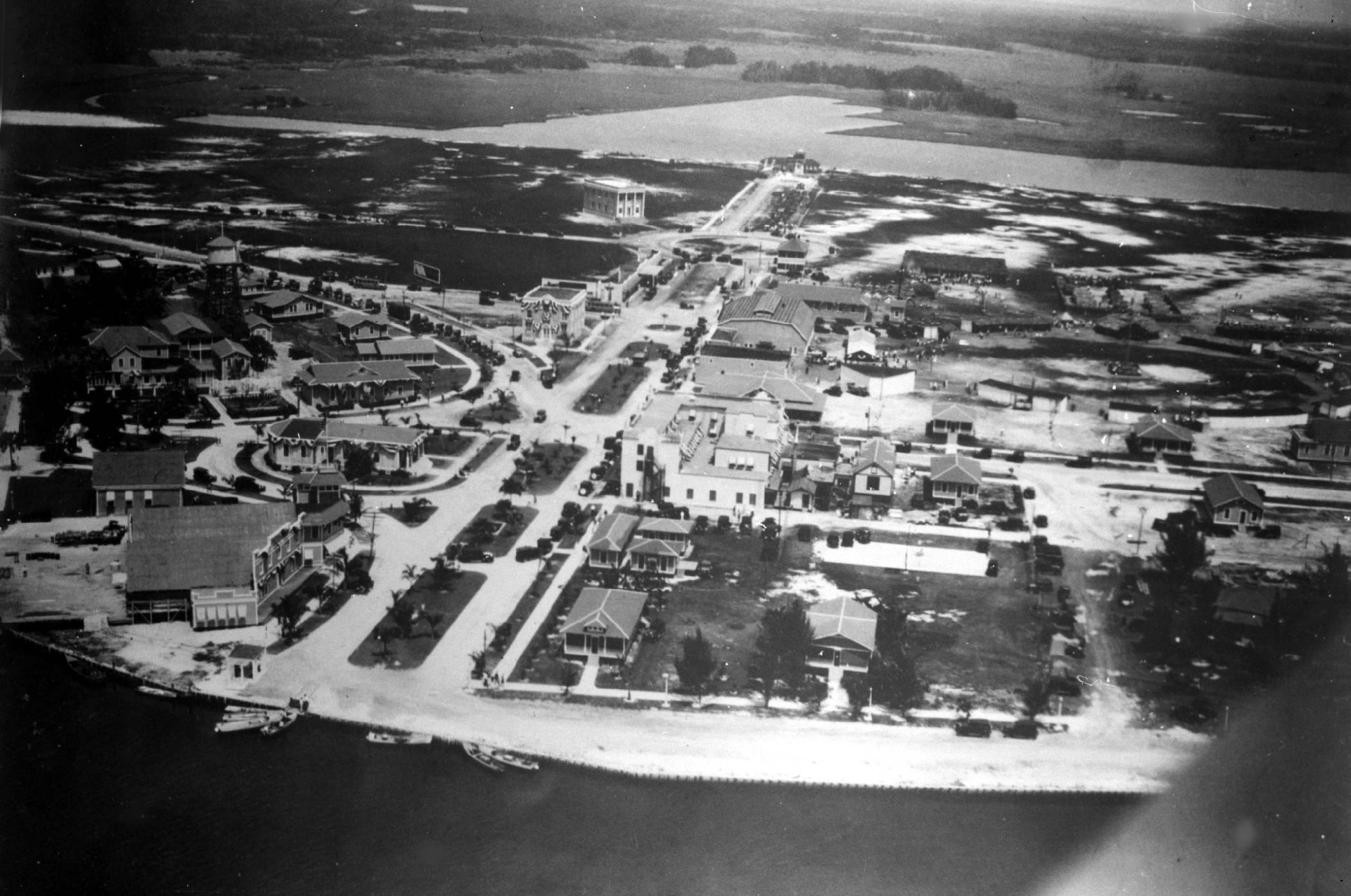
The Birthplace of Collier County. Following the Civil War, pioneer farmers began to settle in the Everglades City area, growing fruits and vegetables for northern markets.
After he and his family spent several years working local land owned by early settler William Smith Allen, George Storter Jr. purchased the townsite from him in 1889 for $800.
Storter built a grand home on the bank of the river (which the land’s previous owner had renamed the Allen after its humbler beginnings as “Potato Creek”) that would in later years be expanded and renamed the Rod & Gun Club by Barron Collier. Today that waterway is known as the Barron River.
George Jr. also opened a general store and applied for a Post Office. When the postal service rejected the name Chokoloskee (as the whole region was then referred to), brother Bembery suggested the name “Everglade” which he had seen used to demarcate the region on older nautical maps. The Eveglade (the “s” was added by Collier in 1923) post office opened in 1891.
Storter soon discovered that wealthy northerners flocking to the region for legendary hunting and fishing experience would pay top dollar for guides and expanded and expanded his home to accommodate these clients.
Millionaire advertising mogul Barron Gift Collier came to Florida in 1911 in pursuit of a new account, but instead purchases the expansive home and private island of Chicago streetcar magnate John Roach. Roach and his business partner Walter Langford also sold Collier their 300-acre grapefruit grove at Deep Lake (now a part of the Big Cypress National Preserve) 16 miles north of Everglade(s). A small, narrow-gauge railroad using a Model T fitted with flanged wheels to ride the track as its locomotive connected the grove to the frontier settlement at Everglade. This was the first piece of land that Collier purchased in the region that would later be known as Collier County.
Collier improved the railway and was soon moving crates of citrus through this American Jungle to Everglade where they were loaded on boats and shipped to Key West, New York, and beyond. The railroad was later purchased by the Atlantic Coastline System, converted to standard-gauge, and added as an extension to their Haines City Line. The Deep Lake Railway was the first railroad in Collier County.
As a highly successful entrepreneur, Collier couldn’t help but notice the brisk business being done by the Storters as guides for sportsmen and imagine the possibilities his personal brand of advertising and promotion might yield. He made a deal with the Storters, purchasing the entire townsite including their home – which he expanded, improved, and renamed the Rod & Gun Club.
The Rod & Gun Club quickly became not only an international destination for sports fishermen, but also a magnet for celebrities, professional athletes, high-ranking politicians (including several U.S. presidents) and more. Collier would eventually build a 3-story, 45-room hotel across the street from the Rod & Gun to accommodate his growing clientele.
Collier County was established in 1923 with Everglades at its county seat. The town grew quickly, adding a bank, department store and laundry as well as the first streetcar in Florida south of Tampa. Along with the doing a brisk business in tourism, the town became the base of operations for construction of the Tamiami Trail. Completed in 1928, this highway across the Everglades offered new and better economic opportunities up until the advent of the Great Depression.
While the town survived the Depression, it continued to struggle through the 1940s and 50s. As the population and business prospects declined, the Bank of Everglades was moved to Immokalee and the county seat to Naples in 1962.
Today Everglades City remains famous for its own brand of smalltown Southern hospitality. Guests still visit from points around the world, enjoying world-class fishing with 4th an 5th generation guides along with unique local cuisine. The Rod & Gun Club remains in operation and the rich history and heritage of Everglades City as the Birthplace of Collier County is celebrated at Museum of the Everglades.
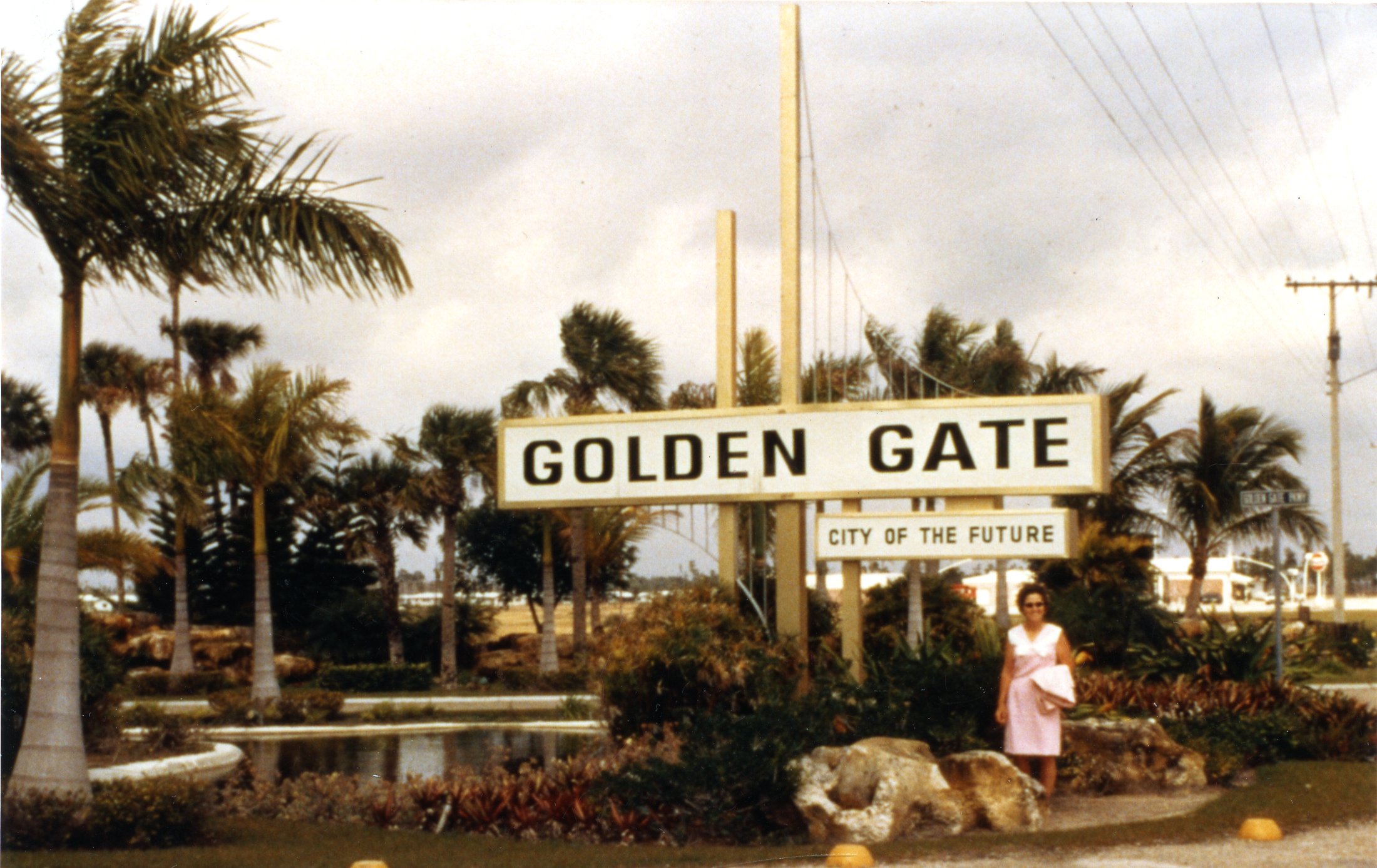
In 1960, the Gulf American Land Corporation – the development company responsible for early Cape Coral – purchased 26,000 acres of land northeast of Naples in Collier County . By the end of 1963, the company had acquired over 114,000 acres of property. The concept behind Golden Gate Estates differed entirely from their Cape Coral strategy, which was designed as a city complete with residential, commercial, and recreational areas . Instead, Golden Gate Estates would be sold as raw acreage in five – acre parcels, leaving the customer to decide what to build on their property. The only areas of Golden Gate that would be planned, however, were Golden Gate City in the southwest corner of the Golden Gate Estates and the never – developed North Golden Gate. In a September 1963 program from the dedication ceremony for the “City of Golden Gate,” Gulf American leaders wrote that the plan of this 2,600 – acre community would mirror Cape Coral , complete with commercial development and planned homesites.
Some information provided by Selling the Dream: The Gulf American Corporation and the Building of Cape Coral, Florida by David E. Dodrill
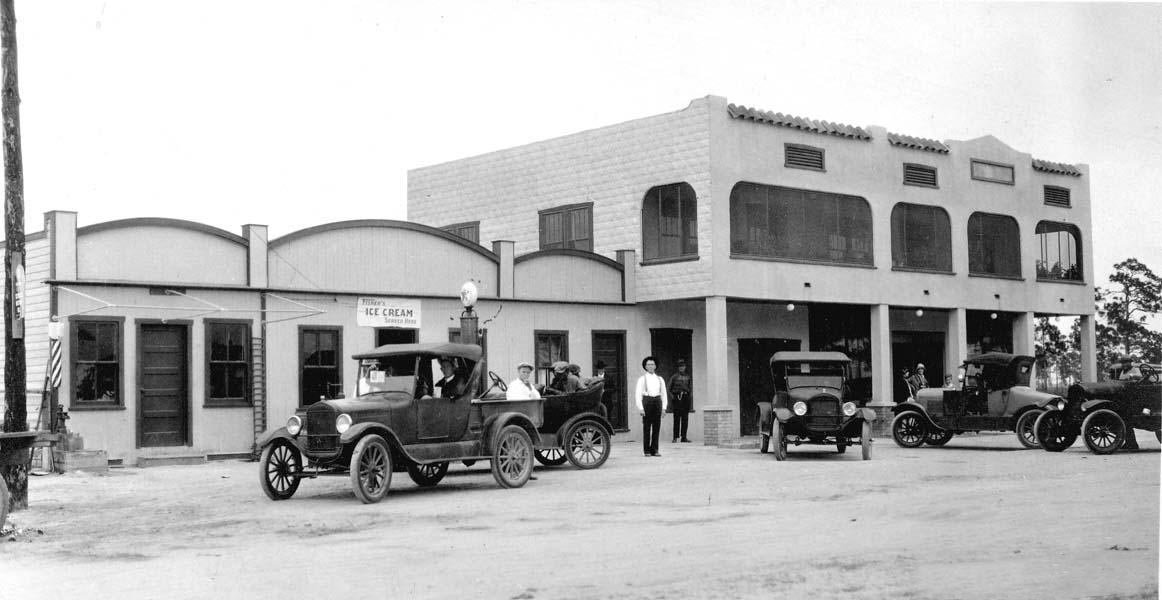
Immokalee, Collier County’s largest non – coastal community, has long been associated with sprawling cattle ranches and a thriving agricultural economy – making it the heart of our region ’ s pioneer history.
The land that Immokalee sits on was originally occupied by the Calusa Indians, especially for fishing in the 1500 – acre Lake Trafford and as an escape for dry, higher ground during the wet season . By the mid – 1800s Seminole Indians coming to the area for refuge after warring with the United States Army would set up hunting camps on the high prairieland, naming it Gopher Ridge after the gopher tortoises who burrowed there. As time progressed, a colorful mix of hunters, trappers, cowmen, missionaries, and Indian traders began to arrive in the are a . The first of these pioneers to establish a permanent settlement was William Allen in 1873 and whose homestead served as the inspiration for the area’s next name – Allen’s Place. It was not until 1893 that Immokalee got its name. An Episcopalian bishop from the first Glades Cross Mission asked 11 – year – old Rose Brown, daughter of prominent trading post owner W.H. “Bill” Brown, what the Mikasuki word for “My Home” would be . She replied “Imokali,” and the bishop proceeded to put Immokalee on the application for the settlement’s first post office.
Immokalee’s population grew slowly and in relative isolation over the next half century. Ranchers and farmers continued coming to the area to establish businesses, with poorer whites, blacks and Tejanos following to work on those ranches and farms. The arrival of Atlantic Coast Line Railway’s overland train route from Labelle in 1921 opened Immokalee to more opportunities for trade and communication. By the 1960s Immokalee’s agricultural industry was booming, and a s a result Immokalee’s population transformed again as Mexican, Haitian, and Guatemalan immigrants , a s well as immigrants from many other Latin American and Caribbean countries , made their way to the fields of Immokalee for a new life in the United States. A part of that population are the migrant farmworkers who come to Immokalee during the winter months especially, to work during the height of picking season.
While Collier County’s coastal cities thrive on tourism for their economies, it is still – unincorporated Immokalee that has become the center of southwest Florida’s multimillion dollar agricultural industry. Its main crops are tomatoes, watermelon, peppers, cucumbers, potatoes, and citrus, however historically, cattle production, lumber and even oil ha ve all been main contributors as well.
Some information provided by Immokalee’s Fields of Hope by Carlene Thissen.
Photo caption: Main Street, Immokalee, c1928.
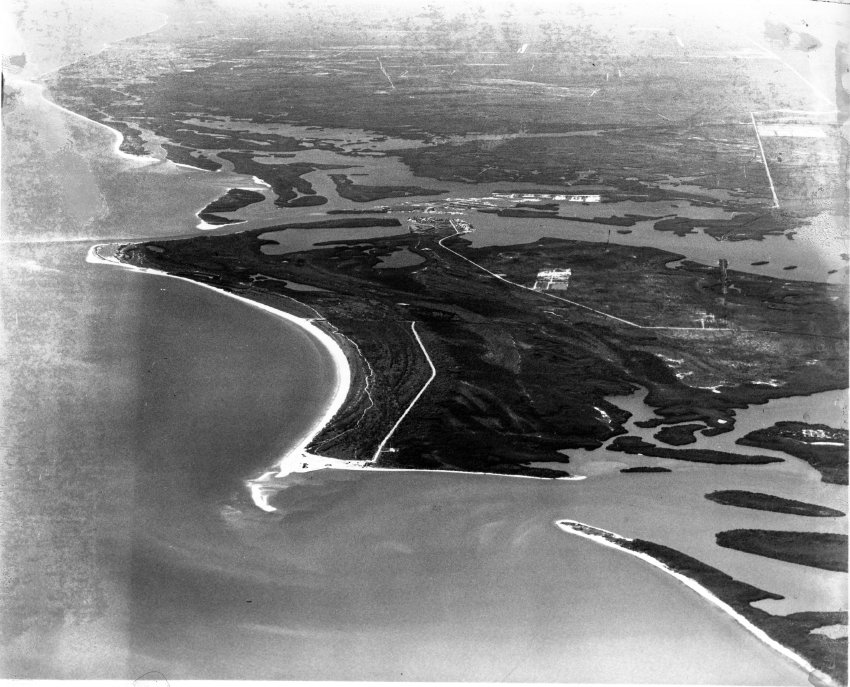
Marco Island has 6,000 years of human habitation. Evidence for the earliest archaic Indian group has been found on the southeastern part of the island. Later came the Muspa Indians, who were here 2,500 years ago. After came the Calusa Indians.
The Calusa’s territory ran the Southwest coast of Florida with Marco Island as the southernmost. An 1896 archaeological dig by Frank Hamilton Cushing uncovered the village. Because of the oxygen-free muck the artifacts were found in, many wood and fiber pieces survived, including the famous Key Marco Cat.
By the 1870s, pioneers made their way down to Marco Island. Two villages sprang up – Marco at the north of the island and Caxambas at the south. Each village grew to include hotels, general stores, post offices, and clam factories. The Colliers (unrelated to Barron Collier) would run the hotel, a store, and post office in Marco. The Barfields would do the same in Caxambas.
The clam factories, Burnham’s and Doxsee’s, were incredibly productive thanks to the invention of the clam dredge by Captain Bill Collier. Beginning the 1930s the clam beds were overfished and the villages of Marco and Caxambas began to decline.
Barron Collier’s family stepped in and purchased the land on most of the Island. In 1964, they sold the land to the Mackle brothers of the Deltona Corporation. The Mackles quickly developed the land between the villages of Marco and Caxambas, dredging and fill to give the island its present shape.
In 1997, the citizens of Marco Island voted to incorporate. The City of Marco Island just celebrated its 25th anniversary.

On the east side of the island John H. Roberts bought a 40-acre shell mound in the 1870s, which he called ‘good land’. He sold it to Samuel Pettit in 1890. The Pettit family occupied this land for decades. Along the way a few other families, either by invitation or marriage to a Petit, moved into the area. However, it would not rise to the level of a village until Barron Collier’s sons paid to have the remaining homes of Caxambas moved to Goodland in 1949.
The Marco Lodge was also moved to Goodland and a version of the building still exist as a restaurant. The famous Ships Ahoy was resurrected from a sunken barge and placed there by the Barfields. Some of the old fishing cottages from Caxambas became part of the MarGood RV park. This hub of community activity was later transformed into the MarGood Harbor Park. It remains the place for Goodland festivals and activities.
Today the village of Goodland is still a close-knit fishing and tourism community.

In the 1955, just across from the village of Marco, a developer named Leland ‘Doc’ Loach set his sights on a couple of mangrove islands. He acquired and cleared 600 acres of land with a vision of a small, quiet fishing village. The modest development was initially reached only by boat, but by the early 60s a road with four bridges connected the isles to Collier Boulevard. This increased accessibility. Early lot sales were modest, but the creation of the Jolley Bridge to Marco Island in 1972 actually helped the Isle of Capri lots and homes by redirecting Marco access from SR 92 to Collier Boulevard, thereby passing Capri Blvd.
Access to county utilities like potable water, power, sewer and mail services were slowly gained and also encouraged the community to fill out. The current residents of this unincorporated village – both full-time and seasonal – continue to honor Doc’s vision through thoughtful development and encouraging community closeness.
To learn more about the island’s 6,000 years of habitation, come check out the Marco Island Historical Museum, which operates as a partnership between Collier County Museums and the Marco Island Historical Society. The Key Marco Cat is on loan from the Smithsonian until April 2026.
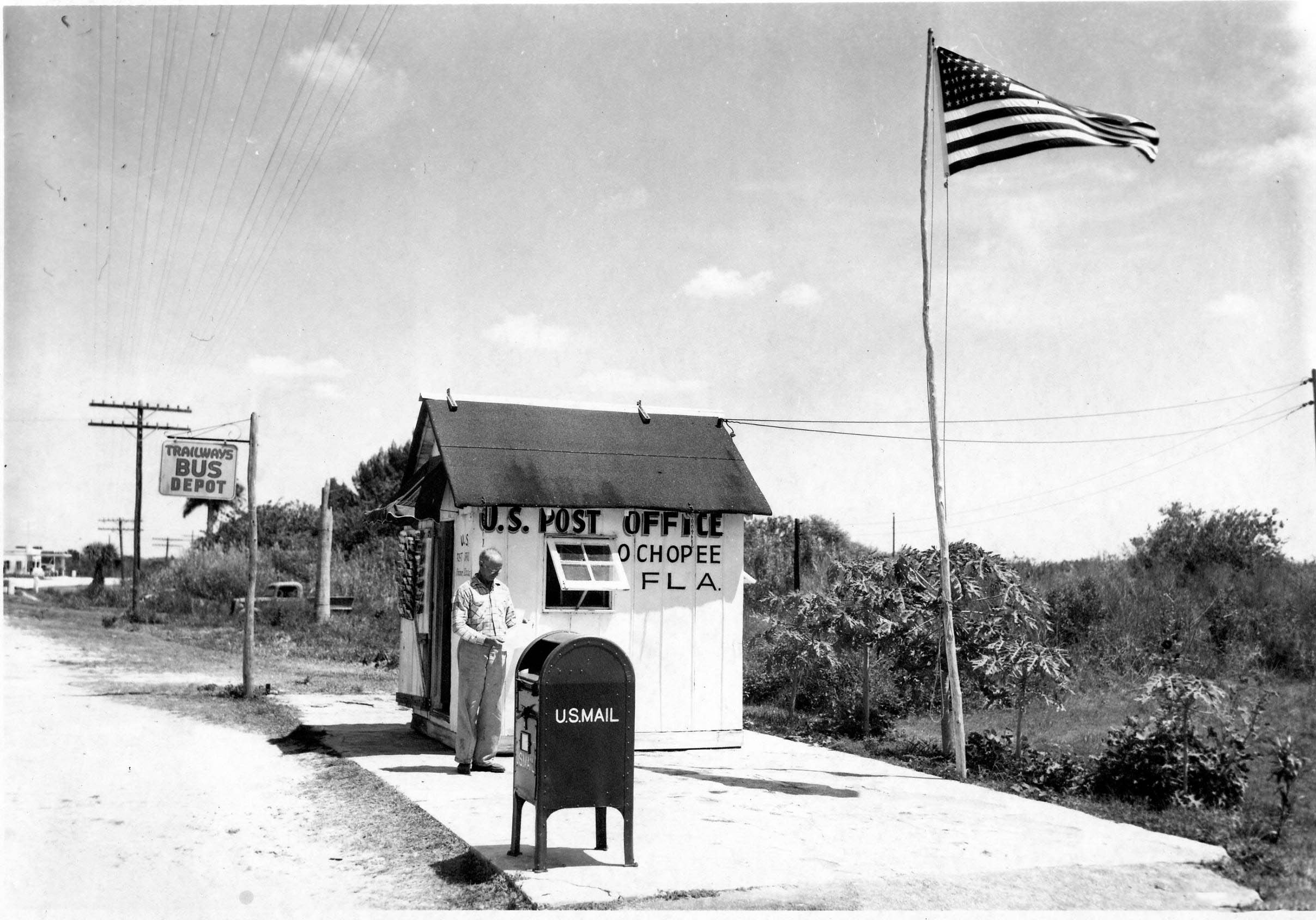
Famous today as the home of the smallest post office in the United States, Ochopee formally began in the 1920s as a tomato-farming community owned by the Gaunt family. Its name comes from the Seminole word for farm. The current post office was originally the Gaunt tomato farm’s irrigation pipe shed, but after a fire destroyed the original general store and post office in 1953, the shed was pressed into service. It remains in operation today. Once a thriving community, only a few homes and businesses still stand. Ochopee is located about 4 miles east of the intersection of U.S. 41 and S.R. 29
We invite all Collier County organizations to participate in this historic celebration by displaying the Collier Centennial Emblem on your website, marketing materials, signage, merchandise, etc.
The Collier Centennial Emblem is currently available in four formats for public use by Collier County businesses and organizations. Organizations using the Emblem will be featured on the Collier County Centennial website. The Emblem can be displayed now and throughout the end of the Centennial year.
To request an eps version of the Emblem, please complete and submit this form. A member of the committee will contact you. Dimensions and color of the Emblem should not be altered.
